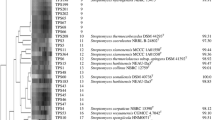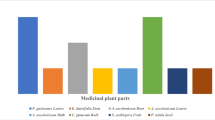Abstract
Phylogenetic diversity of culturable actinobacteria isolated from the intertidal regions of west coast of Maharashtra, India was studied using 16S rRNA gene sequencing. Total of 140 actinobacterial isolates were obtained, which belonged to 14 genera, 10 families and 65 putative species with Streptomyces being the most dominant (63%) genus followed by Nocardiopsis and Micromonospora. Isolates were screened for production of extracellular protease inhibitors (PI) against three pure proteases viz. chymotrypsin, trypsin, subtilisin and a crude extracellular protease from Pseudomonas aeruginosa. Eighty percent of the isolates showed PI activity against at least one of the four proteases, majority of these belonged to genus Streptomyces. Actinobacterial diversity from two sites Ade (17° 52′ N, 73° 04′ E) and Harnai (17° 48′ N, 73° 05′ E) with varying anthropological pressure showed that more putative species diversity was obtained from site with lower human intervention i.e. Ade (Shannon’s H 3.45) than from Harnai (Shannon’s H 2.83), a site with more human intervention. However, in Ade, percentage of isolates not showing PI activity against any of the proteases was close to 21% and that in Harnai was close to 9%. In other words, percentage of PI producers was lower at a site with lesser human intervention.



Similar content being viewed by others
Data Availability
Sequences of 16S rRNA gene of studied isolates are submitted to GenBank NCBI under the accession numbers MN339687–MN339893. Data used for analysis are provided in Supplementary Table 1.
References
von Groll U, Berger D, Altmann T (2002) The subtilisin-like serine protease SDD1 mediates cell-to-cell signaling during Arabidopsis stomatal development. Plant Cell 14(7):1527–1539
Koblinski JE, Ahram M, Sloane BF (2000) Unraveling the role of proteases in cancer. Clin Chim Acta 291(2):113–135
Overall CM, Blobel CP (2007) In search of partners: linking extracellular proteases to substrates. Nat Rev Mol Cell Biol 3:245–257
Roberts IN, Caputo C, Criado MV, Funk C (2012) Senescence-associated proteases in plants. Physiol Plant 145(1):130–139
Ingmer H, Brøndsted L (2009) Proteases in bacterial pathogenesis. Res Microbiol 160(9):704–710
Maeda H (1996) Role of microbial proteases in pathogenesis. Microbiol Immunol 40(10):685–699
Martin MO (2002) Predatory prokaryotes: an emerging research opportunity. J Mol Microbiol Biotechnol 5:467–477
Habib H, Fazili KM (2007) Plant protease inhibitors: a defense strategy in plants. https://academicjournals.org/journal/BMBR/article
Hartl M, Giri AP, Kaur H, Baldwin IT (2011) The multiple functions of plant serine protease inhibitors: defense against herbivores and beyond. Plant Signal Behav 7:1009–1011
Mourão CBF, Schwartz EF (2013) Protease inhibitors from marine venomous animals and their counterparts in terrestrial venomous animals. Mar Drugs 11(6):2069–2112
Karthik L, Kumar G, Keswani T, Bhattacharyya A, Chandar SS, Rao KVB (2014) Protease inhibitors from marine actinobacteria as a potential source for antimalarial compound. PLoS ONE 9(3):e90972
Liu X, Gan M, Dong B, Zhang T, Li Y, Zhang Y et al (4862F) 4862F, a new inhibitor of HIV-1 protease, from the culture of Streptomyces I03A–04862. Molecules 18(1):236–243
Sreedharan V, Bhaskara Rao KV (2017) Efficacy of protease inhibitor from marine Streptomyces sp. VITBVK2 against Leishmania donovani—an in vitro study. Exp Parasitol 174:45–51
Engel S, Jensen PR, Fenical W (2002) Chemical ecology of marine microbial defense. J Chem Ecol 28(10):1971–1985
Pawlik JR (1993) Marine invertebrate chemical defenses. Chem Rev 93(5):1911–1922
Hay ME (2009) Marine chemical ecology: chemical signals and cues structure marine populations, communities, and ecosystems. Annu Rev Mar Sci 1:193–212
Covaleda G, del Rivero MA, Chávez MA, Avilés FX, Reverter D (2012) Crystal structure of novel metallocarboxypeptidase inhibitor from marine mollusk Nerita versicolor in complex with human carboxypeptidase A4. J Biol Chem 287(12):9250–9258
Xie C-L, Xia J-M, Wang J-S, Lin D-H, Yang X-W (2018) Metabolomic investigations on Nesterenkonia flava revealed significant differences between marine and terrestrial actinomycetes. Mar Drugs 16(10):356
Trujillo ME (2016) Actinobacteria. In: eLS. American Cancer Society, pp 1–16. https://onlinelibrary.wiley.com/doi/abs/10.1002/9780470015902.a0020366.pub2
Maldonado LA, Stach JEM, Pathom-aree W, Ward AC, Bull AT, Goodfellow M (2005) Diversity of cultivable actinobacteria in geographically widespread marine sediments. Antonie Van Leeuwenhoek 87(1):11–18
Ward AC, Bora N (2006) Diversity and biogeography of marine actinobacteria. Curr Opin Microbiol 9(3):279–286
Ruocco N, Costantini S, Palumbo F, Costantini M (2017) Marine sponges and bacteria as challenging sources of enzyme inhibitors for pharmacological applications. Mar Drugs 15(6):173
Haygood MG, Schmidt EW, Davidson SK, Faulkner DJ (1999) Microbial symbionts of marine invertebrates: opportunities for microbial biotechnology. J Mol Microbiol Biotechnol 1(1):33–43
Mehbub MF, Lei J, Franco C, Zhang W (2014) Marine sponge derived natural products between 2001 and 2010: trends and opportunities for discovery of bioactives. Mar Drugs 12(8):4539–4577
Watve M, Shejval V, Sonawane C, Rahalkar M, Matapurkar A, Shouche Y et al (2000) The “K” selected oligophilic bacteria: a key to uncultured diversity? Curr Sci 78:1535–1542
Zobell CE (1941) Studies on marine bacteria, I : the cultural requirements of heterotrophic aerobes. J Mar Res 4(1):42–75
Magarvey NA, Keller JM, Bernan V, Dworkin M, Sherman DH (2004) Isolation and characterization of novel marine-derived actinomycete taxa rich in bioactive metabolites. Appl Environ Microbiol 70(12):7520–7529
Baig U, Dahanukar N, Shintre N, Holkar K, Pund A, Lele U et al (2020) Phylogenetic diversity and activity screening of cultivable actinobacteria isolated from marine sponges and associated environments from the western coast of India. bioRxiv.
Nguyen L-T, Schmidt HA, von Haeseler A, Minh BQ (2015) IQ-Tree: a fast and effective stochastic algorithm for estimating maximum-likelihood phylogenies. Mol Biol Evol 32(1):268–274
Kalyaanamoorthy S, Minh BQ, Wong TKF, von Haeseler A, Jermiin LS (2017) ModelFinder: fast model selection for accurate phylogenetic estimates. Nat Methods 14(6):587–589
Shintre N, Baig U, Pund A, Patwardhan R, Tamhane V, Deshpande N (2020) Diversity of culturable actinobacteria producing protease inhibitors isolated from the intertidal zones of Maharashtra, India. bioRxiv
Tripathi VR, Kumar S, Garg SK (2011) A study on trypsin, Aspergillus flavus and Bacillus sp protease inhibitory activity in Cassia tora (L.) syn Senna tora (L.) Roxb. seed extract. BMC Complement Altern Med 11:56
Cheung AL, Ying P, Fischetti VA (1991) A method to detect proteinase activity using unprocessed X-ray films. Anal Biochem 193(1):20–23
Jose PA, Jha B (2017) Intertidal marine sediment harbours Actinobacteria with promising bioactive and biosynthetic potential. Sci Rep 7(1):1–15
Solanki R, Khanna M, Lal R (2008) Bioactive compounds from marine actinomycetes. Indian J Microbiol 48(4):410–431
Watve M, Tickoo R, Jog M, Bhole B (2001) How many antibiotics are produced by the genus Streptomyces ? Arch Microbiol 176(5):386–390
Dharmaraj S (2010) Marine Streptomyces as a novel source of bioactive substances. World J Microbiol Biotechnol 26(12):2123–2139
Jensen PR, Mincer TJ, Williams PG, Fenical W (2005) Marine actinomycete diversity and natural product discovery. Antonie Van Leeuwenhoek 87(1):43–48
Lam KS (2006) Discovery of novel metabolites from marine actinomycetes. Curr Opin Microbiol 9(3):245–251
Subramani R, Aalbersberg W (2012) Marine actinomycetes: an ongoing source of novel bioactive metabolites. Microbiol Res 167(10):571–580
Peela S, Kurada VB, Terli R (2005) Studies on antagonistic marine actinomycetes from the Bay of Bengal. World J Microbiol Biotechnol 21(4):583–585
Ramesh S, Mathivanan N (2009) Screening of marine actinomycetes isolated from the Bay of Bengal, India for antimicrobial activity and industrial enzymes. World J Microbiol Biotechnol 25(12):2103–2111
Raja A, Prabakaran P (2011) Actinomycetes and drug-an overview. Am J Drug Discov Dev 1(2):75–84
Simister RL, Deines P, Botté ES, Webster NS, Taylor MW (2012) Sponge-specific clusters revisited: a comprehensive phylogeny of sponge-associated microorganisms. Environ Microbiol 14(2):517–524
Taylor MW, Radax R, Steger D, Wagner M (2007) Sponge-associated microorganisms: evolution, ecology, and biotechnological potential. Microbiol Mol Biol Rev 71(2):295–347
Holmström C, Kjelleberg S (1999) Marine Pseudoalteromonas species are associated with higher organisms and produce biologically active extracellular agents. FEMS Microbiol Ecol 30(4):285–293
Thao NV, Nozawa A, Obayashi Y, Kitamura S-I, Yokokawa T, Suzuki S (2015) Extracellular proteases are released by ciliates in defined seawater microcosms. Mar Environ Res 109:95–102
Obayashi Y, Suzuki S (2005) Proteolytic enzymes in coastal surface seawater: Significant activity of endopeptidases and exopeptidases. Limnol Oceanogr 50(2):722–726
Kumbhar C, Mudliar P, Bhatia L, Kshirsagar A, Watve M (2014) Widespread predatory abilities in the genus Streptomyces. Arch Microbiol 196(4):235–248
Oliveros, JC (2007) Venny. An interactive tool for comparing lists with Venn diagrams. https://bioinfogp.cnb.csic.es/tools/venny/index.html.
Acknowledgements
Financial support for this project was provided by Rajiv Gandhi Science and Technology Commission under the Maharashtra Gene Bank Program. We thank Dr. Milind Watve for his critical comments and suggestions for this manuscript. Thanks are due to Dr. Neelesh Dahanukar for his help in construction of phylogenetic tree. We also thank Mr. Asim Auti for providing Pseudomonas aeruginosa culture and Mr. Chinmay Kulkarni for assisting in the fieldwork.
Author information
Authors and Affiliations
Contributions
ND, VT, NS and RP conceived and designed the study. NS, UB, and AP performed the study. NS and VT analysed the data. NS, VT, and ND wrote the manuscript with inputs from other authors. All authors contributed to the proofreading of the manuscript.
Corresponding author
Ethics declarations
Competing interests
The authors declare no competing interests.
Additional information
Publisher's Note
Springer Nature remains neutral with regard to jurisdictional claims in published maps and institutional affiliations.
This article is present on a repository website and can be accessed on https://www.biorxiv.org/content/10.1101/2020.02.14.949438v2
Electronic supplementary material
Below is the link to the electronic supplementary material.
Rights and permissions
About this article
Cite this article
Shintre, N.A., Tamhane, V.A., Baig, U.I. et al. Diversity of Culturable Actinobacteria Producing Protease Inhibitors Isolated from the Intertidal Zones of Maharashtra, India. Curr Microbiol 77, 3555–3564 (2020). https://doi.org/10.1007/s00284-020-02174-1
Received:
Accepted:
Published:
Issue Date:
DOI: https://doi.org/10.1007/s00284-020-02174-1



